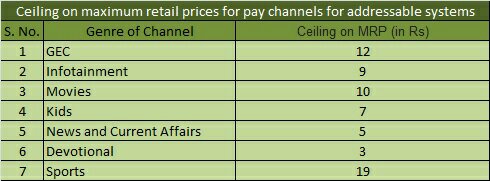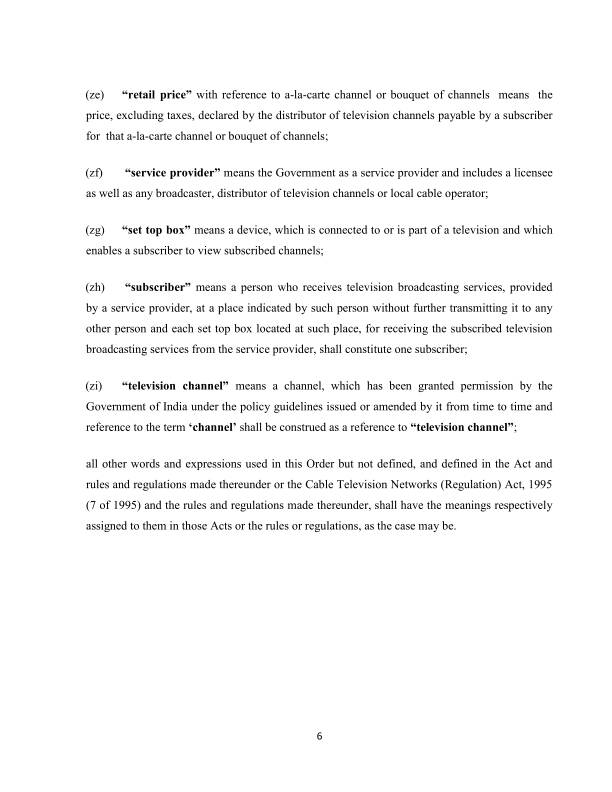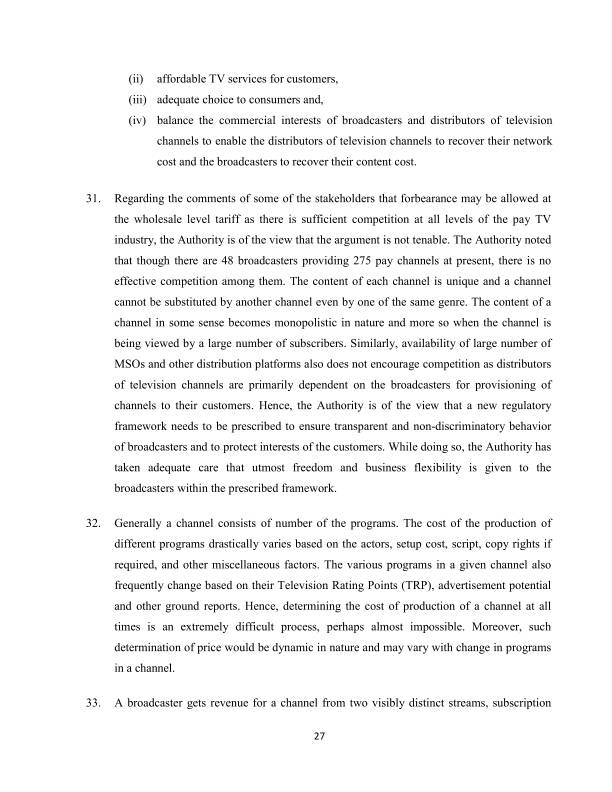rahul1117kumar
Contributor
- Joined
- 21 Jun 2013
- Messages
- 6,758
- Reaction score
- 14,800
In what will come as a setback to the broadcasters, the Telecom Regulatory Authority of India (TRAI) has proposed to put a price cap on different genres of channels in its draft tariff order for digital addressable system (DAS) platforms.
As per the genre caps prescribed by TRAI, sports channels have the maximum retail price (MRP) cap at Rs 19. General entertainment channels have the highest price ceiling of Rs 12. The ceiling for movie channels is Rs 10. Kids and infotainment channel cannot be priced above Rs 7 and 9 respectively. The cap on news channels is Rs 5 while that for devotional channels is Rs 3.
TRAI has also suggested cutting down the number of genres from 11 to seven. Every broadcaster will have to declare a genre for each of its channels among any of the genres, namely (a) Devotional, (b) General Entertainment, (c) Infotainment, (d) Kids, (e) Movies, (f) News and Current Affairs and (g) Sports.
The authority has done away with genres like music, youth, lifestyle and regional.
Broadcasters have to provide the MRP of their channels to consumers. The MRP will have to be consistent with the genre caps.

No price cap on premium channels
In order to have price flexibility, broadcasters will have to declare their channels as ‘premium’. TRAI has said that there will be no price ceiling for channels that are declared by broadcasters as being ‘premium’.
However, there will be genre price caps for channels which are not ‘premium’. A broadcaster is free to place a channel provided by it in any of the prescribed genres and fix the MRP of the channel within that price ceiling.
Tenure of genre and MRP
There will be no change in the genre and MRP of a channel within one year from the date of declaration of genre and MRP by broadcasters.
Frequent change in RIO (reference interconnect offer) will cause inconvenience to subscribers. This will in turn will result in frequent amendments to RIOs and hence in frequent agreements between broadcasters and distributors of television channels, causing inconvenience to subscribers.
MRP on HD channels
As per the draft Telecommunication (Broadcasting and Cable) Services (Addressable Systems) Tariff Order, 2016, the MRP of a pay channel transmitted in standard definition (SD) in a given genre cannot exceed the rate specified for such genre.
The MRP of a pay channel transmitted in HD format cannot be more than three times the maximum retail price of corresponding channel transmitted in SD.
Why genre caps?
So why did TRAI continue with genre ceiling despite fervent appeals by the TV broadcasters to leave it untouched in the new framework?
The broadcast sector regulator believes that the existing framework for genre ceiling is working well. Hence, in order to have continuity, it is of the view that existing genre ceiling should continue.
20% distribution fee for distributors of TV channels
In the new framework, broadcasters will provide distribution fee of 20% on the MRP to distributors of television channels.
Accordingly, TRAI has proposed a new genre ceiling for MRP to customers with adequate scope to cater for additional business margins at 20% of the existing genre ceilings for addressable systems.
The regulator expects that the prices will be regulated by market forces depending on the demand of channels or TRP.
MRP of a channel to the customer
In case, a genre has been retained as it is, MRP of a channel to the customer in that genre will be 1.20 times the existing price cap for that genre for addressable systems.
In case multiple genres have been clubbed to form a new genre, MRP of a channel in that genre to the customer will be 1.20 times the existing price cap of that genre, which has the highest price cap for addressable systems.
Why TRAI seeks to rationalise genres from 11 to 7
As far as reducing the number of genres is concerned, TRAI has said that some of the existing genres have been grouped together to form a new genre, while some genres have been retained as it is.
Keeping in line the trend of developing new and different types of content, TRAI has felt the need to cut the number of genres for 11 to seven.
“The existing categories of genres have resulted into some anomalies. For example, there are many common channels in 36 different GEC genres but their prices are not uniform. The genre categorisation was therefore proposed to be re-examined keeping in view the development of new and different type of content,” TRAI said.
Though similar content in different languages have different areas of dominance, the nature of uptake and popularity remains very similar.
“Clubbing of such channels in one genre will reduce the number of genres and will give greater flexibility to the broadcasters in channel pricing,” TRAI said.
The authority has thus decided to club together similar genres of different language channels for fixation of the genre price cap.
TRAI to review doing away with price ceiling
TRAI said that the ceiling on MRP of a channel will be in operation for a limited period. It may consider deregulation and do away with the genre ceilings in 3–4 years if its feels that there is effective competition.
TRAI’s genre-wise price cap in draft tariff order; Sports MRP at Rs 19, GECs at Rs 12 | TelevisionPost.com
As per the genre caps prescribed by TRAI, sports channels have the maximum retail price (MRP) cap at Rs 19. General entertainment channels have the highest price ceiling of Rs 12. The ceiling for movie channels is Rs 10. Kids and infotainment channel cannot be priced above Rs 7 and 9 respectively. The cap on news channels is Rs 5 while that for devotional channels is Rs 3.
TRAI has also suggested cutting down the number of genres from 11 to seven. Every broadcaster will have to declare a genre for each of its channels among any of the genres, namely (a) Devotional, (b) General Entertainment, (c) Infotainment, (d) Kids, (e) Movies, (f) News and Current Affairs and (g) Sports.
The authority has done away with genres like music, youth, lifestyle and regional.
Broadcasters have to provide the MRP of their channels to consumers. The MRP will have to be consistent with the genre caps.

No price cap on premium channels
In order to have price flexibility, broadcasters will have to declare their channels as ‘premium’. TRAI has said that there will be no price ceiling for channels that are declared by broadcasters as being ‘premium’.
However, there will be genre price caps for channels which are not ‘premium’. A broadcaster is free to place a channel provided by it in any of the prescribed genres and fix the MRP of the channel within that price ceiling.
Tenure of genre and MRP
There will be no change in the genre and MRP of a channel within one year from the date of declaration of genre and MRP by broadcasters.
Frequent change in RIO (reference interconnect offer) will cause inconvenience to subscribers. This will in turn will result in frequent amendments to RIOs and hence in frequent agreements between broadcasters and distributors of television channels, causing inconvenience to subscribers.
MRP on HD channels
As per the draft Telecommunication (Broadcasting and Cable) Services (Addressable Systems) Tariff Order, 2016, the MRP of a pay channel transmitted in standard definition (SD) in a given genre cannot exceed the rate specified for such genre.
The MRP of a pay channel transmitted in HD format cannot be more than three times the maximum retail price of corresponding channel transmitted in SD.
Why genre caps?
So why did TRAI continue with genre ceiling despite fervent appeals by the TV broadcasters to leave it untouched in the new framework?
The broadcast sector regulator believes that the existing framework for genre ceiling is working well. Hence, in order to have continuity, it is of the view that existing genre ceiling should continue.
20% distribution fee for distributors of TV channels
In the new framework, broadcasters will provide distribution fee of 20% on the MRP to distributors of television channels.
Accordingly, TRAI has proposed a new genre ceiling for MRP to customers with adequate scope to cater for additional business margins at 20% of the existing genre ceilings for addressable systems.
The regulator expects that the prices will be regulated by market forces depending on the demand of channels or TRP.
MRP of a channel to the customer
In case, a genre has been retained as it is, MRP of a channel to the customer in that genre will be 1.20 times the existing price cap for that genre for addressable systems.
In case multiple genres have been clubbed to form a new genre, MRP of a channel in that genre to the customer will be 1.20 times the existing price cap of that genre, which has the highest price cap for addressable systems.
Why TRAI seeks to rationalise genres from 11 to 7
As far as reducing the number of genres is concerned, TRAI has said that some of the existing genres have been grouped together to form a new genre, while some genres have been retained as it is.
Keeping in line the trend of developing new and different types of content, TRAI has felt the need to cut the number of genres for 11 to seven.
“The existing categories of genres have resulted into some anomalies. For example, there are many common channels in 36 different GEC genres but their prices are not uniform. The genre categorisation was therefore proposed to be re-examined keeping in view the development of new and different type of content,” TRAI said.
Though similar content in different languages have different areas of dominance, the nature of uptake and popularity remains very similar.
“Clubbing of such channels in one genre will reduce the number of genres and will give greater flexibility to the broadcasters in channel pricing,” TRAI said.
The authority has thus decided to club together similar genres of different language channels for fixation of the genre price cap.
TRAI to review doing away with price ceiling
TRAI said that the ceiling on MRP of a channel will be in operation for a limited period. It may consider deregulation and do away with the genre ceilings in 3–4 years if its feels that there is effective competition.
TRAI’s genre-wise price cap in draft tariff order; Sports MRP at Rs 19, GECs at Rs 12 | TelevisionPost.com




















































